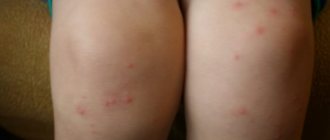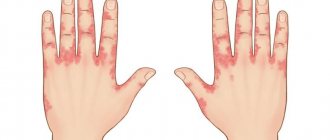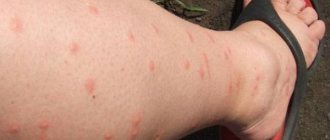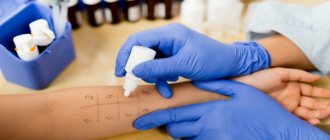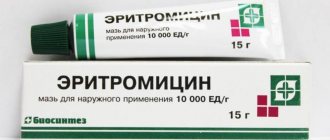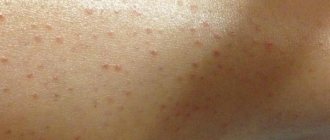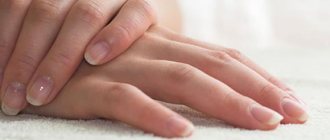Rash during pregnancy is a fairly common occurrence. The reasons for its appearance can be both physiological and pathological. In the first case, the rash will go away on its own after the baby is born; in the second, its appearance may signal an allergic reaction or a serious viral infection that can negatively affect the baby’s development and even provoke a miscarriage. How dangerous is a rash on the body during pregnancy, what can it signal, and most importantly, how to deal with it?
Itching and rash during pregnancy
If during pregnancy the expectant mother discovers a rash, she should immediately consult a dermatologist. Especially if the rash is accompanied by unbearable itching.
There may be several reasons for its occurrence:
- Allergic reaction.
- Viral infections such as rubella, herpes, measles or chickenpox.
- Polymorphic rash, gestational pemphigoid, prurigo of pregnancy, pruritic folliculitis, impetigo herpetiformis and other diseases accompanying pregnant women.
- Chronic skin diseases.
- Insect bites.
- Scabies mite.
Diagnosing a rash is not difficult - a routine visual examination is enough for the doctor. But in order to establish the cause of its appearance, it is necessary to collect anamnesis and identify other accompanying symptoms.
The location of the rash can tell the dermatologist the reason why it occurred. In some cases, the location of the rash does not matter. For example, with allergies, pregnancy dermatosis, or some viral diseases, the rash can spread throughout the body.
If a rash on a pregnant woman’s body is caused by infectious diseases, then the consequences will be extremely dangerous, including miscarriage, premature birth, or the birth of a weak baby with defects and pathologies, hopelessly lagging behind normal development.
Rubella during pregnancy is a viral infection that is accompanied by the following symptoms:
- rash all over the body in the form of small spots that do not merge with each other, pink-red shades;
- high body temperature of about 38 degrees, which can last up to 5 days and cause chills, headache and muscle pain;
- inflammation of the lymph nodes;
- catarrhal phenomena can complement the clinical picture in the form of rhinitis, conjunctivitis, cough or inflammation of the tonsils.
The best prevention against the rubella virus, which causes rubella, is vaccination. Since parents are now free to choose whether they will vaccinate their child, they can do it themselves at the pregnancy planning stage if a blood test reveals the absence of antibodies to a viral infection.
As a result of infection with the rubella virus, miscarriage or premature birth can occur, the development of defects and pathologies in the fetus, and the birth of a fetus delayed in development with possible external deformities.
Herpes during pregnancy - 95% of the world's population is infected with this virus, it is impossible to completely get rid of it, it remains dormant until the immune system weakens its defense. This is exactly what happens during pregnancy. It should be understood that the danger of the herpes virus can only exist if the pregnant woman has not encountered it before (and this is very rare) and became infected for the first time already during gestation. Symptoms:
- a small rash during pregnancy in the area of the lips, nasal mucosa or mouth, accompanied by itching and burning. In case of infection with genital herpes, itchy blisters fill the perineal area;
- elevated body temperature of at least 38 degrees;
- malaise, weakness.
It happens that the herpes virus is asymptomatic; this form is the most dangerous. Therefore, at the stage of pregnancy planning, women must undergo a blood test to determine the presence of antibodies to herpes infection in their blood.
The consequences of fetal herpes infection are terrifying:
- pregnancy fading;
- premature birth;
- stillbirth;
- spontaneous abortion.
Chickenpox is the same type of chickenpox that is best dealt with in childhood. However, if this does not happen and no antibodies to this infection are found in the blood of the expectant mother, the course of the disease itself will be extremely complicated, and the consequences for the health and life of the baby will be terrible. Symptoms:
- increased body temperature;
- vomiting and diarrhea;
- stomach ache;
- 2 days after those described above, the rash spreads throughout the body - at first it is simple red spots, then they fill with liquid.
Chickenpox and pregnancy, however, are compatible; the infection only rarely has a negative effect on the gestation process. In some cases, the baby is diagnosed with congenital chickenpox syndrome, which is expressed in dysfunction of the cerebral cortex, paralysis, and atrophy of the limbs.
Measles is another infection that affects most children during childhood. Symptoms:
- high fever;
- catarrhal phenomena;
- small white rash on the inner surface of the cheeks;
- a large pink rash that gradually spreads from the face to the legs, tends to merge and can last up to two weeks.
If a pregnant woman is infected in the early stages, measles can cause developmental defects in the fetus in the form of damage to the central nervous system with possible dementia of the child (mental retardation), cardiopulmonary diseases of an inflammatory nature with possible death. Defeat in the later stages can provoke the manifestation of congenital measles in the newborn and the development of all kinds of complications, for example, pneumonia.
Fighting rashes
Naturally, it is easier to prevent a rash and overcome it in the earliest stages than to prolong the soreness and spend a lot of time and money on treatment. Therefore, below we will describe some tips that will be useful to every expectant mother.
- First: you should monitor your hygiene as often and carefully as possible, and use baby products instead of regular products.
- Second: carefully monitor your diet and limit the consumption of foods that contain chemicals and allergens. This also includes cosmetics.
- Third: moisturizing some areas of the skin can prevent rashes, and it is advisable to use baby creams for this.
It is also worth considering that the rash can be caused by nervous tension, which means that you should be in calm conditions.
We also recommend reading: Detachment of the ovum in early pregnancy
When a rash has been discovered, it is worth starting an active fight against it: apply cold compresses, but do not get carried away with herbal decoctions, because they can cause allergies.
An excellent solution is baking soda in a proportion of about a tablespoon with water. You should not get rid of the rash on your own, because there can be many reasons for the occurrence of this disease, and only a doctor can assess the severity of the rash, its cause and recommend the necessary drugs to combat it.
Rash on face during pregnancy
The most common cause of a rash on the face during pregnancy is acne, which, in turn, can manifest itself due to hormonal changes and non-compliance with hygiene measures. To minimize the risk of a rash, the expectant mother should regularly visit a cosmetologist and carefully care for her facial skin, using proven cosmetics that suit her personally.
A red rash on the face during pregnancy can also be a consequence of serious viral diseases, such as rubella, measles, chickenpox or herpes. In these cases, the rash may spread throughout the body and be accompanied by other symptoms that will allow the doctor to identify the infection.
Genital herpes during pregnancy
Genital herpes It is genital herpes during pregnancy that is one of the most dangerous.
Most often it manifests itself secondarily, after the latent phase. There are also rare cases of infection with this virus directly during pregnancy. In the primary form, symptoms such as itching, burning, and the formation of groups of blisters in the genital area will be observed. The rash is white and watery and may drain. An increase in body temperature and even urinary retention are also possible. This is a clear clinical picture, and most often the woman immediately seeks help and begins to treat the disease.
But more frequent cases are when the infection lies dormant in the nuclei of the spinal cord, and during pregnancy begins to manifest itself atypically. At the same time, the clinic does not at all remind about genital herpes. A watery, red rash may appear on the hands in the form of blisters. As with the standard form, the rash on the hands will be accompanied by itching, burning, and there may be no hyperpigmentation spots. The complications of this infection are very serious, especially for the baby’s health, namely:
- Spontaneous miscarriages;
- Formation of various defects in the nervous and cardiovascular systems;
- Premature birth;
- Insufficient oxygen supply to the fetus through the placenta.
These complications are possible due to the fact that the virus passes through the placenta. It has been proven that without proper treatment of genital herpes in the mother during pregnancy, 75% of newborns have congenital forms of herpes infection and severe developmental defects.
Rash on belly during pregnancy
A rash on the abdomen can be caused by dermatosis of a pregnant woman, which, in principle, appears only in expectant mothers. They begin, as a rule, from the area around the navel, gradually growing throughout the abdomen.
Viral infections can also manifest themselves as a rash on the abdomen during pregnancy.
Causes of rash during pregnancy
The causes of rashes during pregnancy can be varied. Thus, rashes occur against the background of herpes infection, chicken pox and other diseases.
Blisters may appear on the skin, which dry out and crust over time. Then everything disappears and only a stain remains. Under no circumstances should you scratch these blisters, as this can lead to infection and the appearance of ulcers.
Red rashes can also occur due to scarlet fever. A herpes infection can cause the rash. Often this phenomenon occurs after exposure to the sun. This is the so-called sun allergy.
Rash in pregnant women, especially on the stomach, can be caused by hormonal imbalance. It usually manifests itself in the third trimester. Dermatosis also causes unpleasant pimples and redness. It often goes away on its own, a couple of weeks after birth.
Rashes can be caused by various infections and viruses. They are often associated with the presence of defects and anomalies in the fetus. In this case, you need to take action.
Often the rash is associated with poor diet. This reaction of the body can occur to food, medications and other irritants. A rash during pregnancy can appear both locally and throughout the body.
Types of rashes during pregnancy
A dermatologist will help determine the cause of the rash not only where it is located, but also the type of primary element:
- Blister. It usually occurs immediately after an insect bite or an allergic reaction. It looks like a reddish round element rising above the surface of the skin.
- Vesicle (bubble). Talks about herpes, eczema or again, allergies. A small cavity that is filled with a translucent liquid.
- Bulla (bubble). It looks the same as a vesicle, but is larger - over 5 mm in diameter. May occur as an allergy or reaction to a drug.
- Pustule (pustule). A cavity filled with pus that rises above the surface of the skin. It happens with acne, as well as with various skin diseases.
- Spot. Or pigmentation, change in skin color. It may be a manifestation of pregnancy in the form of a vertical stripe in the lower abdomen or small spots on the face or chest. Or it speaks of some pathology, for example, urticaria or impetigo.
- Knot. A small lump, less than 3 cm, which may indicate eczema, ringworm or warts.
- Knot. A large compaction, which can indicate serious pathologies or formations, but it is very rare.
Allergic rash during pregnancy
An allergic rash during pregnancy often resembles hives. Small spots of different shapes begin to appear on the skin. This phenomenon is often accompanied by unpleasant itching. Similar symptoms can be observed with allergies to internal organs.
An allergic rash can appear quite suddenly. At the same time, characteristic itching appears, lacrimation and runny nose appear. The rashes on the skin have a raised appearance and are quite noticeable.
The main thing is to try not to scratch the rash. This may cause the situation to worsen. You can get rid of unpleasant sensations with the help of antiallergic drugs. True, during pregnancy, in many cases, taking medications is prohibited. Therefore, consultation with a doctor is necessary.
An allergic rash will not go away on its own. It must be eliminated; moreover, the irritant itself must be removed. Otherwise, the rash during pregnancy will continue throughout the entire period, which will bring a lot of inconvenience.
Rash during early pregnancy
The rash itself becomes dangerous for the expectant mother and fetus only if too large an area is affected, since in this case there is a risk of developing a generalized infection, sepsis. In other cases, the rashes are absolutely safe. The real threat may be what caused it.
The greatest danger to the health of the expectant mother and the life of the baby are infections such as rubella, chickenpox, measles or herpes. Appearing in the first trimester, they cause pathologies in fetal development, sometimes incompatible with life and ending in miscarriage. Or the baby will be born with defects and pathologies, weakened and lagging behind its development, and the pregnancy itself will be extremely difficult.
Treating rashes during pregnancy
Treatment of rashes during pregnancy is carried out carefully and under the supervision of a doctor. If the rash is caused by a scabies mite, it is advisable to use ointments that contain tar or sulfur.
Treatment can be carried out using special cosmetics. If the case is quite complex, then a blood transfusion may be prescribed. But during pregnancy this process is not allowed.
Decoctions prepared from medicinal herbs bring great benefits. If the rash occurs on the face, you can perform cosmetic cleansing. Thanks to her, it will be possible to remove everything and open the abscesses. All this is carried out under the guidance of a qualified specialist.
During pregnancy, you should not abuse medications. Therefore, doctors often recommend resorting to traditional methods. You should follow a special antihistamine diet. It is advisable to give up sweets and coffee. Products containing a lot of fiber are also prohibited. Thanks to this, you can reduce the risk of developing dermatosis.
There is no need to try to remove the rash on your own, especially during pregnancy. After all, in order to begin quality treatment, it is necessary to determine the cause of this phenomenon. You can only analyze your own nutrition on your own and try to remove possible irritants.
If the rash is not going to “go away” at all, you need to speed up this process. Ointments and creams based on menthol, camphor, pramoxine or diphenhydramine are perfect for this. Don't skip moisturizing lotions. It is easy to remove a rash during pregnancy, but this should be done under the guidance of your doctor.
Rash during late pregnancy
If the cause of the rash in the later stages was rubella, then it no longer carries the same danger to the fetus as in the first trimester. However, the expectant mother will have to undergo all kinds of screening tests in order to identify the development of pathologies and deformities in the baby, and in some cases, doctors may advise terminating the pregnancy. Only in the case of a lesion after the 30th week of pregnancy does the question of its termination not arise. The process of labor itself is taken under strict control, since the rubella virus will negatively affect it, causing severe bleeding.
Chickenpox, which appears in an expectant mother just a week before giving birth, can contribute to the development of neonatal chickenpox in the baby. This condition is dangerous due to its complications - encephalitis, inflammatory diseases of the liver and respiratory tract.
Diagnosis of rash during pregnancy
Diagnosis of rashes during pregnancy must be carried out without fail. First of all, the doctor must perform a visual examination of the situation. The main characteristics of the elements of the rash are also taken into account. A lot of useful information can be obtained from a visual inspection.
The patient is examined by a dermatologist. A visual inspection alone is not enough in most cases. It is necessary to confirm or deny the presence of a particular disease. Therefore, clinical tests are mandatory. It is possible to carry out cultures of the secretions of ulcers.
Diagnosis includes blood tests, which provide additional information. Based on all the data obtained, complex treatment is prescribed. In many cases, it requires the use of certain medications. But, because We are talking about pregnant girls; alternative ways to solve the problem are being found. After all, medications can make the situation worse. Rash during pregnancy must be treated correctly.
Rash during pregnancy: how to treat it
Treatment of rash during pregnancy directly depends on the cause that caused it.
- For example, if we are talking about an allergic rash during pregnancy, then the doctor must determine what exactly triggered it. In case of food allergies, allergenic foods are excluded. If cosmetics are not suitable, it becomes necessary to replace them with another, hypoallergenic one. If you are allergic to a pet, the expectant mother will have to limit contact with it, etc. In severe cases, the use of special anti-inflammatory ointments may be prescribed.
- Infections require special careful monitoring of the patient by a doctor, often in a hospital, since they can lead to miscarriage, premature birth, and the development of defects and pathologies. Treatment is usually symptomatic; often the doctor may recommend an abortion.
- Dermatosis in pregnant women goes away on its own after delivery, and if the rash does not bother or itch, then no treatment is required. Or again, symptomatic treatment is carried out to alleviate the patient’s condition.
- For scabies, special preparations are prescribed, which are used to treat all the pregnant woman’s clothes, furniture, as well as the clothes of all her relatives living with her under the same roof.
Powders and talc effectively relieve friction in the area of irritation and are absolutely safe during pregnancy. Medications that doctors can prescribe to relieve itching in the area of the rash include:
- Fenistil gel. Prescribed for insect bites, eczema, urticaria, itchy dermatoses. Use during pregnancy is allowed in the first trimester after consulting a doctor; in the second and third trimester it is not recommended to use the gel on large areas of the body.
- Pimafukort. It can be prescribed for dermatoses, but its use during pregnancy should be accompanied by medical supervision and only after consultation.
- Akriderm. Prescribed for simple and allergic dermatitis, eczema, neurodermatitis. Long-term use during pregnancy, and especially in the first trimester, is not recommended.
It should be understood that in order to treat a rash it is necessary to clearly establish the cause that caused it. This can only be done by a doctor when examining the patient, collecting anamnesis and establishing symptoms other than the rash. Self-medication can cause consequences even more painful than the absence of treatment as such.
Bottom line
No pregnant woman can protect herself from a rash, because even heat can cause it. If you are sure that it was sweating that caused the rash, then special compresses, keeping the body clean, and moisturizing creams will help. But if formations on the skin appear after eating certain foods, then you cannot do without consulting a doctor, because an allergic reaction is a signal that the liver is not coping with its job. In this case, the doctor will prescribe special medications that will cleanse the body of toxins.
Self-medication is considered dangerous not only for the pregnant woman, but also for the fetus, so following the advice of girlfriends and forums can lead to problems not only with the female body, but also with the baby’s body. This means that in cases where something new appears on the body that is unusual for your body, you should immediately go to the doctor.
Rash during pregnancy: photo
I have a red rash on my stomach. What it is?
This kind of rash can be caused by a skin disease, which is described in medical textbooks as polymorphic dermatosis of pregnancy (PDP).
Of course, it sounds a little scary, but in fact, such a diagnosis is a very common and, most importantly, harmless manifestation of rash and itching. Typically, dermatosis begins in the third half of pregnancy. Polymorphic dermatosis of pregnancy is usually caused by severe stretching of the skin and can occur during the first pregnancy, during pregnancy with twins, or with significant weight gain. PDB usually appears as small, red, inflamed bumps. As you approach the time of labor, the rash will slowly disappear, and after childbirth there will be no trace of it. Doctors often use steroid creams and antihistamines to treat PDB. Consult your doctor to find the treatment that is right for you. In order to eliminate the rash and itching that appears, a pregnant woman should definitely seek help from a doctor who will carefully observe the picture of events in order to apply the most effective method of treatment. Try to limit yourself and your baby from stress and anxiety, do not self-medicate, consult a doctor and, with his help, drive this disease away from yourself and your loved ones.
Let's summarize: rash during pregnancy
Treatment of the rash, as a rule, is not required - the causes that caused it are treated, and if it is accompanied by severe itching, it is removed with the help of special cooling ointments and gels, which are allowed during pregnancy.
A rash during pregnancy is a signal that the expectant mother has some kind of malfunction in her body, and this should not be ignored under any circumstances. It is better to immediately make an appointment with a dermatologist and tell in detail how, under what circumstances the rash appeared and what other signs accompany it. The sooner he makes a diagnosis, the easier the treatment will be and the fewer consequences for the health of the expectant mother and her baby.
Rash symptoms during pregnancy
Symptoms of a rash during pregnancy depend on the cause of the rash. So, this phenomenon can occur against the background of infectious diseases. The symptoms of herpes infection, chickenpox and other similar diseases are the same.
Bubbles appear on the body, containing liquid inside. Under no circumstances should you scratch them, otherwise they will get infected and form pustules. Over time, the bubbles dry out on their own and become crusty, then fall off and disappear altogether.
The allergic manifestation of the rash is in some way similar to urticaria. Spots of various shapes may appear on the skin, often they are very itchy. With allergies, similar symptoms appear on internal organs.
With scarlet fever, specific red rashes appear. The rash itches and manifests itself mainly in the groin, lower abdomen and buttocks. In some cases it can be found on the face. The symptoms of the disease are very specific. The skin around the mouth and nose becomes pale, and the cheeks are bright red. Over time, the rash begins to itch and peel.
With a herpetic infection, blisters appear in the form of a hyperemic spot. They contain liquid inside. Over time, the blisters dry out and become crusty. In some cases, they open up, forming erosion. This disease causes headache, general malaise, itching and tingling. A rash during pregnancy can occur for a number of reasons and be accompanied by specific symptoms.
Itching and rash during pregnancy: video
Source
Most rashes during pregnancy are not directly caused by pregnancy and can appear for the same reasons as in anyone (for example, contact dermatitis or allergies). But there are a number of specific dermatoses that are characteristic exclusively for the period of bearing a child. In such cases, the rash appears as a result of many changes and the interaction of various factors in the body of a pregnant woman and goes away after childbirth. There are 4 main skin diseases during pregnancy:
- atopic dermatitis (dermatosis) of pregnant women (Atopic eruption of pregnancy or AEP);
- polymorphic dermatosis of pregnant women (English: Pruritic urticarial papules and plaques of pregnancy or PUPPP, as well as eruption of pregnancy or PEP);
- pemphigoid of pregnant women (eng. Pemphigoid gestationis or PG);
- intrahepatic cholestasis of pregnancy (ICP).
Acne during pregnancy
Acne during pregnancy is quite common. Moreover, it appears spontaneously. You can meet it on the face, chest and back. Some women note that it disappears on its own after pregnancy.
Acne occurs due to hormonal imbalance. This often occurs against the background of previously taking birth control pills. Therefore, during pregnancy the situation becomes significantly worse.
It is worth noting that during pregnancy the level of male sex hormone increases. The sebaceous glands specifically influence this process and therefore acne appears. A large amount of subcutaneous fat is produced, which clogs the glands. There is no need to worry about this, everything returns to normal after pregnancy.
To reduce the appearance of the rash, it is enough to use ordinary cosmetics. Special gels for washing and creams are suitable. A rash is normal during pregnancy, especially if it is acne.
Atopic dermatitis of pregnancy
Atopic dermatitis of pregnancy
Atopic dermatitis of pregnancy is a general term that includes three conditions:
- eczema of pregnancy;
- itchy folliculitis of pregnancy;
- prurigo of pregnant women.
Atopic dermatitis accounts for about half of all skin diseases diagnosed during pregnancy.
Signs, symptoms and character
This rash can be severely itchy and usually appears on the arms, legs, or torso.
Eczema is often characterized by red, scaly patches, small bumps, or flaky skin.1 It appears most often in first-time singleton pregnancies and usually in the first or second trimesters, in unusual places such as the face, palms, and crooks of the arms and legs.2
Itchy folliculitis first affects the torso and can spread to other parts of the body. The nodules that form on the skin contain pus and may resemble pimples. This rare condition occurs in the last two trimesters and usually lasts two to three weeks.
Prurigo can occur at any time. About 1 in 300 women may be affected by this dermatosis, which lasts from several weeks to several months after childbirth. Appears as itchy or crusty papules on the arms, legs, or abdomen.3
A woman may experience repeated flare-ups of atopic dermatitis with subsequent pregnancies.
Causes
The nature of this disease indicates a problem with the immune system, which is accompanied by a tendency to eczema, asthma or hay fever. Often atopic dermatitis occurs in the medical history of several family members. It is associated with poor skin barrier function, making it dry and sensitive.4
Treatment
Atopic dermatitis can be treated with topical creams/ointments and oral antihistamines. Some women are also prescribed oral steroids.
How does it affect pregnancy and the fetus?
Atopic dermatitis does not pose a risk to the mother or fetus.1
Herpes Zoster
As stated above, there are two forms of this disease: chicken pox and shingles. As a rule, people get chickenpox in childhood, and this virus settles in the nerve ganglia, and after various problems with the immune system, it makes itself known in the form of shingles. This type of lichen is more common during pregnancy.
The rash appears in the form of bubbles, which are located in groups along the nerves. Their localization can be very different, but most often it is the arms, lower back, back, and stomach. Severe itching, burning, and fever last for about a week, and then recovery begins. For the fetus, this virus is especially dangerous after infection immediately before childbirth, but there are cases of early miscarriages and deformities in children and in the chronic and latent course of the disease. Therefore, immediately after the appearance of such a rash, massive systemic and local treatment begins.
Polymorphic dermatosis of pregnancy
Polymorphic dermatosis of pregnancy
Polymorphous dermatosis of pregnancy is an itchy rash that occurs in approximately 1 in 150 pregnant women, most often during first and multiple pregnancies.
Signs, symptoms and character?
Typically, the rash occurs in the third trimester. Appears on the skin of the abdomen in stretch marks and then spreads to the torso and limbs, usually not rising above the chest. It can take on a variety of forms - papules, plaques or blisters. It usually goes away after birth within 1-2 weeks. Most likely, polymorphic dermatosis that occurred during the first pregnancy will not recur during subsequent ones or will be expressed in a much milder form.3
Causes
The medical community still does not know why polymorphic dermatosis of pregnancy develops. There are several points of view.
- Skin stretching . In the last few months of pregnancy, the growth rate of the fetus is especially high, and the skin of the abdomen stretches very intensively. The connective tissues can become damaged, causing an inflammatory process that can lead to a rash.
- Immune response to the child's cells . Another theory is that some fetal cells migrate throughout the mother's body and can trigger an immune response that results in a rash. This theory may explain why polymorphic dermatosis sometimes persists after childbirth, as fetal cells continue to circulate for a short period of time in the mother's body.
Treatment
There is no cure for this skin condition, but there are a number of ways to help relieve symptoms:
- Do not scratch the affected areas. This can expose irritated skin to bacteria and other germs.
- Cool compresses or ice. Apply a cool, damp cloth or towel to the affected area when it feels itchy or swollen. Applying an ice pack wrapped in a cloth for 15 to 20 minutes several times a day may also help relieve your condition.
- Oatmeal. Oatmeal baths treat many allergic or inflammatory skin diseases. Colloidal oats contain a group of phenols called avenanthramides, which have anti-inflammatory and antioxidant properties. Oats also contain antioxidants such as vitamin E and ferulic acid. Research, including a 2014 review report by a member of the American Academy of Dermatology (AAD), shows that oatmeal baths reduce itching and other skin problems in people with conditions such as atopic dermatitis and eczema.
- Moisturizers. Itchy skin can easily become dry. To prevent further irritation, apply moisturizers or emollients to inflamed or dry skin as needed. Glycerin is usually the most recommended natural remedy.
- Chamomile. Chamomile's soothing properties are widely used to treat skin conditions, and many over-the-counter anti-itch creams and lotions contain chamomile extract. In a 2020 study in Spain, 30 people with lichen planus who applied chamomile gel to the affected areas of the skin reported a reduction in itching, burning and pain. It is important to remember that some people may be allergic to chamomile.
- Peppermint. The plant contains high doses of menthol. Most studies show that menthol can reduce itching when taken diluted or applied directly to the skin in topical products. Menthol is also a weak analgesic and can numb the area of skin affected by the rash.
- Clove oil. Cloves contain high doses of antioxidants and antimicrobials, particularly the phenol eugenol. In a 2020 Egyptian study, 25 people who applied petroleum jelly followed by clove oil to areas of itchy skin daily for 2 weeks experienced a reduction in symptoms compared to a similar group who used petroleum jelly alone.5
- Steroid and antihistamine drugs. Hydrocortisone ointment 1% applied to the affected areas of the rash may help relieve itching. Examples of antihistamines that are considered safe during pregnancy include diphenhydramine and cetirizine. Although these medications are considered safe for pregnant women, be sure to consult your doctor before using them.
How can you relieve itchy skin?
A pregnant woman should try to limit the use of warm baths or showers, and also avoid the use of detergents and cleaning products that contain strong chemicals and fragrances, as these can also cause rashes and severe itching.
When showering, try to use a gentle moisturizing soap or pH-balanced face and body skin care products. The expectant mother needs to moisturize the skin of her abdomen well, and it is advisable to use only non-perfumed products for moisturizing. Oils for moisturizing the skin, without any additives, can relieve itching that could be associated with the appearance of stretch marks due to an ever-growing belly. For eczema, it is necessary to use emollient creams and ointments, which will be prescribed to the woman by an allergist. It is also permissible to smear the affected areas of the skin of the abdomen with calamine lotion or take a bath by adding a little oatmeal or chamomile to the water. But be careful, all oils and herbs are folk remedies, and therefore it is most likely unknown how effective they are. However, they are safe to use during pregnancy and may actually help you.
Try to avoid overheating. Heat only worsens rashes and skin itching; it’s not for nothing that doctors recommend wearing loose cotton clothes in hot weather and staying indoors or in the shade more. Among other things, overheating during pregnancy is not at all safe for the health of the unborn baby.
Pemphigoid of pregnancy
Pemphigoid of pregnancy
Pemphigoid gravidarum is a very rare autoimmune disease affecting on average 1 in 40,000 to 50,000 pregnant women.
Signs, symptoms and character
This dermatosis, which occurs in the second or third trimester, causes red, itchy nodules to form around the navel and spread to other parts of the body over several days or weeks. The face, scalp, palms, and soles of the feet are usually not affected. After two to four weeks, the papules turn into large, red, fluid-filled blisters. They may decrease or go away on their own late in pregnancy, but 75–80% of women with pemphigoid gravidarum experience flare-ups during labor. The rash usually goes away after the baby is born without treatment. Outbreaks of pemphigoid gravidarum often occur in the postpartum period (during menstruation, when using oral contraceptives).6 This dermatosis usually recurs in subsequent pregnancies and tends to be more severe.1
Causes
In this disease, the pregnant woman's immune system attacks the placenta. Placental tissue contains cells from both parents. Cells received from the father may contain molecules that are recognized by the mother's immune system as foreign.
Paternal cells are present in every pregnancy, but autoimmune diseases such as pemphigoid occur only in some cases. It is not entirely clear why the mother's immune system can react this way. But it has been observed that the placenta of women diagnosed with pemphigoid contains molecules known as MHC class II (major histocompatibility complex), which are not found in this location.
Treatment
If symptoms are mild, antipruritic creams such as topical corticosteroids may be prescribed. They soothe the skin by locally reducing the level of immune system activity in areas affected by the rash.
Over-the-counter allergy medications may also be helpful. These include the following foods that do not cause drowsiness:
- cetirizine;
- fexofenadine;
- Loratadine.
Diphenhydramine has a hypnotic effect and is best taken at night.
During pregnancy, always consult your doctor before taking any medications, even over-the-counter ones.
For mild cases of pemphigoid gravidarum rash, home remedies may also be suggested to combat the itching:
- cool the skin with ice or cold compresses;
- stay in cool or air-conditioned rooms;
- take baths with Epsom salts or oats;
- wear light cotton clothing.
If itching and irritation worsen, oral corticosteroids will likely be prescribed. Because these drugs work by reducing the activity of the immune system, the lowest effective dose should always be used.
How does it affect pregnancy and the fetus?
Pemphigoid of pregnancy, which usually occurs in the later stages, is not life-threatening for the woman or child. However, a 2009 study found that developing a rash in the first or second trimester can lead to poor pregnancy outcomes.
The study examined the records of 61 pregnant women with pemphigoid from the UK and Taiwan. Adverse outcomes found in women with early onset disease included preterm birth and low birth weight.
The study also found that treatment with systemic (oral) corticosteroids did not have a significant effect on pregnancy outcomes.
In rare cases (about 1 in 100,000), the rash may appear in newborns6, but it is usually mild and goes away within a few weeks.1
Preventing rashes during pregnancy
Prevention of rashes during pregnancy plays a huge role. It is important to keep your skin clean. In most cases, ignoring the rules of personal hygiene leads to the appearance of various types of rashes. In particular, acne and allergies.
Skin needs to be taken care of, especially if it is oily or sensitive. Cosmetic products that can be used both as treatment and prevention are also perfect.
It is important to review your diet. Indeed, in most cases, the irritants that provoke the appearance of a rash are located there. It is necessary to observe how the body reacts to a particular food. If a rash and itching appears, you should exclude certain foods.
Naturally, existing diseases cannot be neglected. You should always consult your doctor. A timely response to emerging problems will prevent the problem from getting worse. Rash during pregnancy can be prevented with common preventive measures.
Intrahepatic cholestasis of pregnancy
Scratching on the legs with obstetric cholestasis
Intrahepatic cholestasis of pregnancy, also known as pruritus gravidarum2, is a rare liver disease that causes itchy skin. It is estimated that 1 in 146 to 1293 women may experience cholestasis while pregnant.
Signs, symptoms and character
Most often it appears in the third trimester as itching on the palms and soles of the feet, gradually spreading throughout the body. It differs from other dermatoses during pregnancy in that it is rarely accompanied by a rash. But the itching is so intense that it can lead to scratches on the scratched areas. Yellowing of the skin may also occur as the disease progresses. Some women experience fatigue, nausea, or abdominal discomfort.
The condition of a woman with intrahepatic cholestasis of pregnancy improves within a few days after birth. However, the disease usually recurs in subsequent pregnancies and may also recur when oral contraceptives are started.
Causes
The cause of pregnancy itch is unknown. Liver function slows down, bile acids accumulate in the blood, bilirubin levels increase, which causes itchy skin. Obstetric cholestasis is often hereditary.
Treatment
Intrahepatic cholestasis is usually treated with ursodeoxycholic acid, an oral drug that reduces bile acid levels and relieves itching. Treatment should begin immediately after diagnosis and continue until the baby is born.
Is the rash dangerous?
The rash itself is dangerous only if the affected area is large, since there is a risk of developing a generalized infection and sepsis.
But a rash on the body during pregnancy can often be a symptom of dangerous diseases, for example:
- infections dangerous to the fetus - measles, rubella, chickenpox, herpes;
- severe allergic reactions and toxicoderma - a rash can only be the first manifestation, and then Quincke's edema develops.
Impetigo herpetiformis is also a dangerous disease in pregnant women, but it is very rare.
Treatment for rash during pregnancy depends on its cause. Only acne does not require a visit to the doctor; it is more of a cosmetic problem. Any other rash must be demonstrated to a specialist.
Allergic rashes during pregnancy are treated with a hypoallergenic diet and taking antihistamines. Local administration of anti-inflammatory ointments is possible in severe cases.
Infections in pregnant women are treated strictly under the supervision of a doctor! Some infections in the first trimester, unfortunately, can lead to abortion for medical reasons. In the second and third trimester, they are not so dangerous, but can also affect the development of the child.
Dermatoses in pregnant women can go away on their own, without treatment. To relieve symptoms, medicinal herbs, ointments and lotions are used.
For scabies, it is necessary to prescribe special products, treat clothes and furniture with them, as well as all family members. It is necessary to discuss the choice of drug with a dermatologist, since many are contraindicated during pregnancy.
